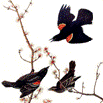Wildlife Damage Management, Internet Center for
Document Type
Article
Date of this Version
September 1966
Abstract
I realized this past winter that redwings form the base for an international problem, and so I went down to see Jim Caslick in Florida. Unfortunately, I picked the wrong season. I misjudged the weather for when I went down in May to get experimental birds it was pretty hot. Next year I'll be a bit more careful and go down during the winter time. I want to discuss something a bit different but still in line with crop damage by red-winged blackbirds. I want to relate the damage assessment that we're making in agricultural corn to bird behavior. We've taken a small deviation to one way or another in an attempt to come up with a few ideas of how and why large masses of birds feed in corn. For one, we don't really believe that they need the corn to exist. This is the first premise; it may or may not be right. The reason we believe this to be correct is that it has been pointed out to me that there are some very old records of large bird populations in the Lake Erie area. Some of the first journals of the French fur trappers coming into Ontario, and I suspect through parts of the U.S., point out large masses of redwings, which were misidentified as starlings. In the Windsor region, Jacque Lery, in his journals through Ontario speaks of the large masses of birds. He doubted whether any community development would ever be started in the Windsor region because of the pest problem that these birds posed to the small grain crops. This was in 1749. Two hundred years later we are still talking about the same things. Therefore I want to briefly review what really the problem is. Individual birds really cause no problem. I think that we would probably accept this, But, most of the research work to date has been done on individual birds, i.e., the territorial breeding bird. There is a very good reason for this emphasis because the breeding period is the easiest time of year to study them and we can define their movements and habits best at this time of year. But little work has been dedicated to what I would call post-breeding behavior or post-breeding population work, and there is an equally good reason for this fact. It is very difficult to make these latter studies and it is very difficult to under¬stand the results in such a study. The reason is very simple. It is because of complexity of numbers. The movements of one bird can be understood and perhaps the movements of 10 birds, and perhaps a 100. But when one increases these numbers in a logarithmic fashion to a thousand, 10 thousand, 100 thousand, a million, or 10 million, one can quickly lose track of what is happening. These latter numbers of course, are the numbers that we're dealing with. This is a post-breeding phenomena. Typically when redwings (and other birds) lose their so-called breeding territoriality they flock together. This fact is well known. But the important thing that we have to recognize is that birds do not lose their territoriality. They carry some sort of a territory with them the whole year. They carry a spatial territory around themselves--a certain distance that is inviolate and they do not allow another bird to come within this distance. So, with this premise, maybe we can analyze what is going on in the post-breeding behavior. What then is really happening when these widely dispersed masses of breeding birds get together and congregate in an intensive manner in a certain region?



Comments
Includes panel discussion and question/answer session with Dr. Donald Balser, James Caslick, Dr. Maurice L. Giltz, and Dr. M. I. Dyer.